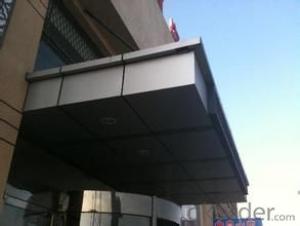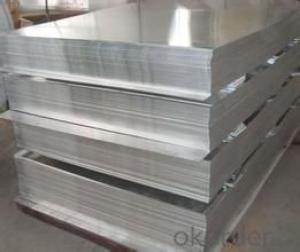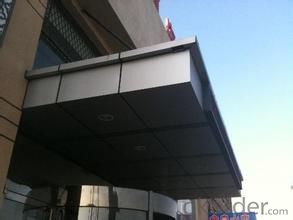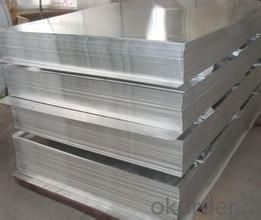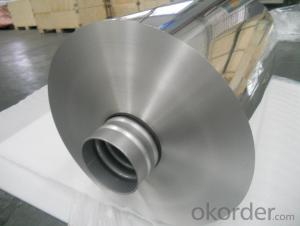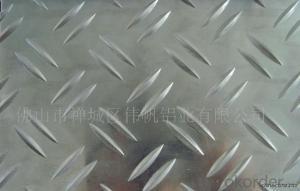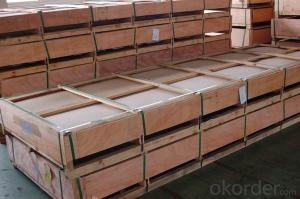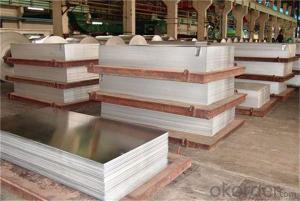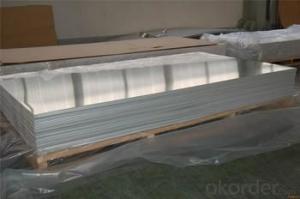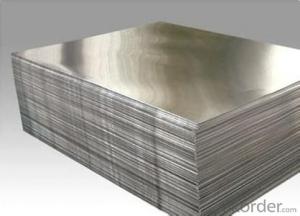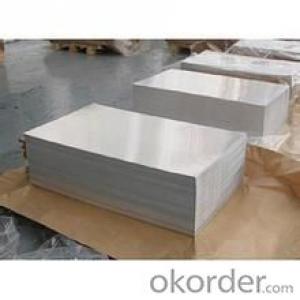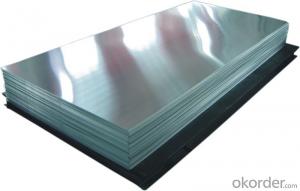Copper Plated Aluminum Sheets - Mill Finish Aluminum Sheet for Panels
- Loading Port:
- China Main Port
- Payment Terms:
- TT OR LC
- Min Order Qty:
- -
- Supply Capability:
- -
OKorder Service Pledge
OKorder Financial Service
You Might Also Like
Aluminium is a relatively soft, durable, lightweight, ductileand malleablemetalwith appearance ranging from silvery to dull gray, depending on the surfaceroughness. It is nonmagnetic and does not easily ignite. A fresh film ofaluminium serves as a good reflector (approximately 92%) of visible lightand an excellent reflector (as much as 98%) of medium and far infraredradiation. The yield strength of pure aluminium is 7–11 MPa,while aluminium alloys have yield strengths ranging from200 MPa to 600 MPa. Aluminium has about one-third the densityand stiffness of steel. It is easily machined,cast, drawn and extruded.
Aluminium alloys (or aluminum alloys; see spellingdifferences) are alloysin which aluminium(Al) is the predominant metal. The typical alloying elements are copper, magnesium,manganese,silicon,tin and zinc. There are twoprincipal classifications, namely casting alloys and wrought alloys, both of which are furthersubdivided into the categories heat-treatableand non-heat-treatable. About 85% of aluminium is used for wrought products,for example rolled plate, foils and extrusions.Cast aluminium alloys yield cost-effective products due to the low meltingpoint, although they generally have lower tensile strengthsthan wrought alloys. The most important cast aluminium alloy system is Al–Si,where the high levels of silicon (4.0–13%) contribute to give good castingcharacteristics. Aluminium alloys are widely used in engineering structures andcomponents where light weight or corrosion resistance is required
Specification:
Alloy: AA1050, 1060, 1100,AA3003, 3005, 3015, 5052, 5754, 5083,8011, etc
Temper:H14/16/18/22/24/32, HO etc.
Thickness:0.2mm—100mm
Width: 100mm—2300mm (Can be slitted)
Application: Roofing, Can stock, Marine plate,Anti-slipery purpose in vehicles, packing and appliance.
Features:
1. Excellent quality of products
2. Quick delivery
3. Best service to clients
4. BV,SGS avalible
5. No buckle o waveness
6. Tension leveling
7. Certificate of Origin
8. Form A,E
Packaging Detail:
Carton ,Woodenpallet with plastic protection packing ,standard seaworthy packing or as yourrequest.
ProductionCapacity:
AnnualProduction capacity of 600,000 tons.
Products areexported to United States, Canada, U.A.E, Brazil, Mexico,Thailand, Vietnam,Nigeria etc, over 100 countries andregions all over the world.
Production Line:
CNBM aluminumproduction base is comprised of 18 aluminumannealers, 10 coil and foilmills, 4 continuous production lines, 2hot rolling production line and 3prepainted lines.
FAQ:
1. What is the form of payment?
Normally 30% TT, L/C
2. Type of quotation?
FOB, CFR, CIF
3. Port of loading?
Shanghai port
4. Delivery time?
30 day after client’s deposit
- Q: write a balanced equation for the reaction between aluminium metal and potassium hydroxide in water
- Potassium Aluminum Hydroxide
- Q: Is it possible to incorporate windows made from recycled materials into a construction project?
- <p>Yes, you can use windows made from recycled materials in your project. There are eco-friendly windows available that are manufactured using recycled glass or other sustainable materials. These windows can offer similar performance to traditional ones while reducing the environmental impact of your construction. It's important to check the quality and certifications of the recycled windows to ensure they meet your project's requirements.</p>
- Q: What are the common applications of aluminum sheets in construction?
- Aluminum sheets have various applications in the construction industry due to their unique properties and versatility. Some of the common applications of aluminum sheets in construction include roofing, siding, and cladding. Aluminum sheets are lightweight yet durable, making them ideal for roofing applications as they can withstand harsh weather conditions, such as strong winds and heavy rainfall, without corroding or deteriorating. In siding applications, aluminum sheets are commonly used due to their ability to resist rust and corrosion. They provide an aesthetically pleasing finish to buildings, enhancing their overall appearance. Additionally, aluminum sheets can be easily shaped and bent to fit the desired design, making them suitable for curved or intricate architectural designs. Cladding is another common application of aluminum sheets in construction. Aluminum cladding is used to cover the exterior walls of buildings, providing insulation and protection against weather elements. It helps to reduce the energy consumption of buildings by acting as a thermal barrier, keeping the interior cool in summer and warm in winter. Aluminum cladding is also fire-resistant, making it a safe choice for construction projects. Moreover, aluminum sheets are frequently used in the construction of windows and doors. Their lightweight nature makes them easy to handle and install, while their strength ensures durability and longevity. Aluminum sheets can be powder-coated or anodized, allowing for a wide range of color options to suit different architectural styles and preferences. Overall, the common applications of aluminum sheets in construction encompass roofing, siding, cladding, windows, and doors. Aluminum's lightweight, durable, and corrosion-resistant properties make it an excellent choice for various construction projects, providing both functional and aesthetic benefits to buildings.
- Q: Can aluminum sheets be used for architectural cladding?
- Yes, aluminum sheets can be used for architectural cladding. Aluminum is a popular choice for cladding due to its durability, lightweight nature, and resistance to corrosion. It is commonly used in both residential and commercial buildings for its aesthetic appeal and versatility in various architectural designs.
- Q: Can the aluminum sheets be bent or formed into different shapes?
- Aluminum sheets possess the remarkable ability to undergo effortless bending and shaping procedures. Displaying exceptional malleability, aluminum is capable of being manipulated with utmost ease, devoid of any risk of fracturing or shattering. This unique characteristic renders it a perfect choice for diverse applications that necessitate adaptability and tailored specifications. Employing an assortment of methodologies including press brakes, rollers, and specialized forming tools, aluminum sheets can be flexed, folded, rolled, or formed effortlessly. Such remarkable versatility enables the fabrication of intricate shapes and structures, rendering aluminum an immensely favored option in sectors like construction, automotive, aerospace, and manufacturing.
- Q: This question asks for an explanation of the various grades of aluminum sheets and the distinctions between them.
- <p>Aluminum sheets are categorized into different grades based on their alloy composition, which affects their properties such as strength, formability, and corrosion resistance. Common grades include 1000 series (99.00% aluminum, soft and malleable), 2000 series (aluminum-copper alloys, strong and heat treatable), 3000 series (aluminum-manganese alloys, good formability), 5000 series (aluminum-magnesium alloys, good strength and corrosion resistance), and 6000 series (aluminum-silicone-magnesium alloys, good strength and extrudability). Each grade has specific applications based on its characteristics, with 1000 series used for general purposes, 2000 series for aircraft structures, 3000 series for decorative applications, 5000 series for marine environments, and 6000 series for structural components.</p>
- Q: My aluminum storm windows are wasting energy in my home, however, the $7000 estimate to replace them is beyond (well beyond) my comfort zone.I know aluminum is a great conductor of hot and cold. I was considering cleaning the frames, and then coating them with a brush on clear or possibly white liquid rubber to reduce the conductivity. Any idea as to how much benefit I'll realize? Is flammability going to be an issue?I need some solid answers please. Trolls go get your two points elsewhere.Thanks.Your help is much appreciated.
- Plastic coating will not stick to aluminum well. You will have to sand it first then use a aluminum metal primer. This is very labor intensive and you would be better off making new frames from wood or vinyl
- Q: 5052 can aluminum plate be machined with laser cutting machine?
- Can cut, thickness less than 5, cutting edge without burr, not melt.
- Q: Can the aluminum sheets be used for architectural cladding?
- Yes, aluminum sheets can be used for architectural cladding.
- Q: Can aluminum sheets be used for roofing applications?
- Yes, aluminum sheets can be used for roofing applications. Aluminum is a durable and lightweight material that offers excellent resistance to corrosion, making it suitable for use in roofing. It is commonly used in residential and commercial roofing projects due to its longevity and ability to withstand various weather conditions.
Send your message to us
Copper Plated Aluminum Sheets - Mill Finish Aluminum Sheet for Panels
- Loading Port:
- China Main Port
- Payment Terms:
- TT OR LC
- Min Order Qty:
- -
- Supply Capability:
- -
OKorder Service Pledge
OKorder Financial Service
Similar products
Hot products
Hot Searches
Related keywords
